Rotating Shift Schedules: Manager’s Guide + Examples
Try When I Work for free
If you’re always working different shifts, or stuck on a difficult shift (like nights), it’s hard to balance your personal life with work. You’re at work so many different days of the week, or inconsistent hours each day. Or you never see the light of day and your family while they’re awake.
That’s the reality for many of your employees, and it’s one of the reasons employees leave a job for one somewhere else.
That’s where a rotating schedule comes in. You can keep your shifts running smoothly without putting an unfair schedule burden on employees. In this complete guide, we’ll show you how a rotating schedule works, give you some examples of rotating shift schedules, and help you set up what works best for you.
Key takeaways
- Rotating shift schedules can boost employee morale and enhance teamwork, as they allow everyone an equal chance at preferred shifts.
- There are several types of rotating shifts, such as frequent, slow, rotating weekend, and partial rotating shift schedules.
- Implementing a rotating shift schedule can result in a better customer experience and improved operational efficiency.
- Despite their benefits, rotating shifts may pose challenges for employee work-life balance and health, making careful planning essential.
- Advanced scheduling tools, like When I Work, can facilitate the creation and management of complex rotating shift schedules.
Looking to learn about rotating shift schedules? Keep reading or watch our YouTube video and learn about the various types of rotating shift schedules, determine which is right for you, and how to create a more balanced schedule that benefits your employees and your business.
Table of contents
- What is a rotating shift schedule?
- How a rotating shift schedule works
- Different types of rotating shift schedules
- Rotating work schedule examples
- Rotating shift schedule comparison table
- Benefits of the rotating shift schedule
- Challenges of the rotating shift schedule
- How to create a rotating work schedule for your business
- Plan your rotating schedules with When I Work
- FAQs: Rotating schedules
Get started on setting up your rotating shift schedule with a free 14-day trial of When I Work.
What is a rotating shift schedule?
A rotating shift schedule is a work plan where employees alternate between different shifts, such as day, evening, and night, on a regular basis. This schedule ensures round-the-clock coverage, balances workloads, and accommodates diverse operational needs. Rotations may follow weekly, biweekly, or monthly cycles to ensure fairness and prevent fatigue.
Rotating shift schedules in action
Imagine you run a restaurant, where all the service staff want to work in the evenings because they make the most tips. Or, they don’t want to work the evening shifts because they enjoy those nights with their friends and families.
A rotating shift schedule would help make sure that everyone works through all the available shifts in a fair way, without causing burnout or playing favorites.
How a rotating shift schedule works
A rotating schedule means that employees work a particular shift over a set amount of time. Employees on a rotating schedule might work the same shift on different days (rotation of days), or they might actually work different shifts (rotation of time).
Even though a rotating shift means changed schedules, it’s done in a cyclical way.
Your shifts might be morning to afternoon and afternoon to night. Or you might have set up day, swing, and night shifts. If you’re open 24/7, you might have four shifts.
The more cyclical your schedule, the easier it is for employees to balance work and personal life.
Different types of rotating shift schedules
Start your free 14-day trial of When I Work! Click here to start scheduling your employees today.
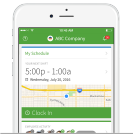
There are four main types of rotating shifts:
Frequent rotating shifts
Frequent rotating shifts involve employees regularly switching between different work shifts, such as morning, evening, and night, over short time intervals (e.g., weekly or biweekly). This schedule ensures operational coverage and workload balance, but may lead to challenges like disrupted sleep patterns and reduced long-term productivity if not managed carefully.
Slow rotating shift schedule
A slow rotating shift schedule allows employees to work one shift (e.g., day, evening, or night) for an extended period, such as several weeks or months, before transitioning to a different shift. This approach minimizes disruption to sleep patterns and provides better work-life balance compared to frequent rotations.
Rotating weekend schedule
A rotating weekend schedule assigns employees to work weekends on a rotating basis, ensuring fair distribution of weekend shifts among team members. Employees alternate working specific weekends while having others off, accommodating both operational needs and personal time. This approach helps maintain work-life balance and reduces scheduling conflicts.
Partial rotating shift schedule
A partial rotating shift schedule combines fixed and rotating shifts. Some employees maintain a consistent shift, while others alternate between different shifts (e.g., day and night). This approach balances stability with flexibility, ensuring operational coverage while accommodating employee preferences or specific business needs.
Varying the rotation schedule is where you can really customize the rotation concept to be a perfect fit for your teams. There are several approaches you can use:
- DuPont schedule: This 24/7 system uses four staggered teams working two twelve-hour shifts, which comes to 42 hours a week during a four-week cycle. Each team works four consecutive nights, followed by three days off, then they work three consecutive days, with one day off before switching back to nights. Finally, the fourth week of the schedule gives the team seven consecutive days off before the whole cycle starts over again.
- Pitman schedule: This system is similar to DuPont in that you have four teams working two twelve-hour shifts. However, it’s over a two-week cycle.
- 24-48 schedule: With this system, you’ll have three teams working 24-hour shifts. After a shift is complete, they have 48 hours off.
- 4-3 schedule: Using six teams with overlapping ten-hour shifts in a three-week cycle, this system gives you full 24-hour coverage with no gaps at the shift change.
There are other options, and you can customize them based on what you need. But you can see that there’s natural flexibility in how you create the teams, define the shifts, and set up the rotation cycle.
Rotating work schedule examples
Some of that may sound complicated, but it doesn’t need to be. Using automated scheduling, like the When I Work employee scheduling software, makes it easy to create shifts and schedules that make any of these rotation cycles possible. Instead of manually creating a paper work schedule, When I Work lets you set up the rotation in the system, block out the teams, and assign the shift rotation cycles.
Here’s what the different types of rotating schedules might look like in a scheduling software:
DuPont schedule
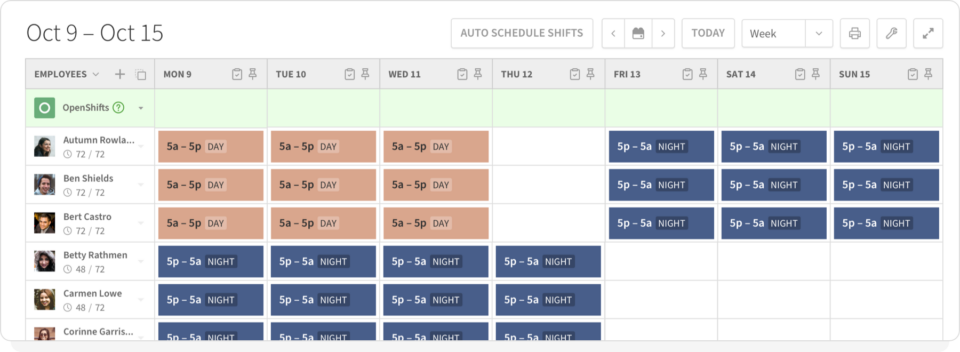
The DuPont schedule cycles through day shifts and night shifts, with enough time off between each to give workers time to adjust. That’s really important for their mental and physical health. This schedule also gives each team an entire week off each month, so it helps them rest and recharge.
If you’re using When I Work to run the DuPont schedule, it’s really easy to set up your template and copy and paste it over each month. You’ll save so much time on scheduling, and you’ll be able to post the schedule in plenty of time for your team to plan around the shifts. This increases employee engagement and keeps morale high.
Here are a few things to keep in mind:
Advantages of the DuPont schedule
The DuPont schedule is notable for its blocks of time off. This makes it popular among employees and gives them time to adjust between the day and night shifts.
- Employees get a consecutive week off each month.
- Employees get an additional seven days off each month.
- It ensures that there are always two teams on the clock.
Disadvantages of the DuPont schedule
Despite the time off, however, there are some downfalls to this schedule. The rotating nature of the schedule means that you have to make sure it’s always up to date so your team can plan accordingly.
- Employees don’t have set days off; it rotates and varies from month to month.
- Employees face a week where they’ll work six 12-hour shifts, and it can be exhausting.
- This schedule can be tricky to set up and manage, and mistakes may happen if automation isn’t used. Scheduling software, like When I Work, can make it easier to ensure there are no human errors when building the schedule and workers are all rotated through shifts fairly.
If the DuPont schedule offers too many gaps, you might be interested in a similar schedule that runs on a two-week cycle.
Pitman schedule
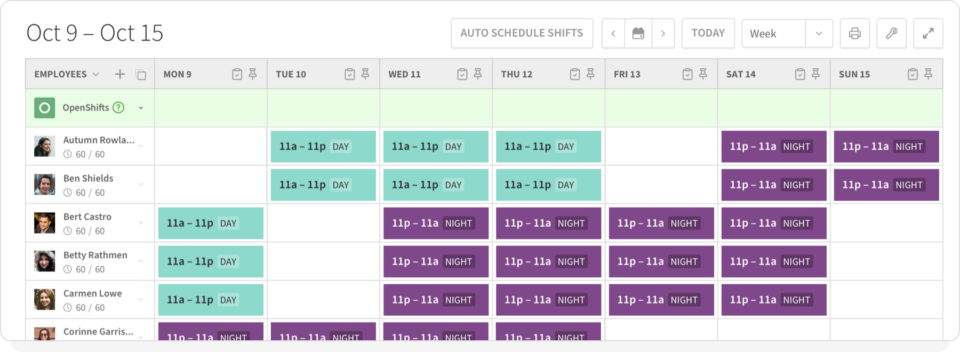
The Pitman schedule runs on a two-week cycle, so if you need the flexibility a shorter schedule offers, this one is a great option. There’s still plenty of time off for employees to adjust between day and night shifts, but without the large gaps of the DuPont schedule.
Again, when you’re dealing with rotating shift schedules, using When I Work and scheduling templates helps simplify and automate the process. You’ll be able to implement scheduling rules as well, so you can keep track of overtime and get better control over labor costs.
Here are some things to think about when it comes to the Pitman schedule:
Advantages of the Pitman schedule
Like the DuPont, the Pitman offers significant days off. However, if you’re worried about the seven days off, the Pitman is a great alternative. It also has a shorter cycle time, which gives you a chance to make any adjustments quicker.
- Employees can form close connections with the team (squad) they work with.
- Every other weekend each team has a three-day weekend; there are two weeks with only two working days each month.
- Employees don’t work more than three consecutive days.
- Could be mixed with a different night shift and used as day shift only.
- Long shifts make it easier for employees to complete tasks in full.
The Pitman schedule isn’t perfect, though. Here are some drawbacks to consider before you implement:
Disadvantages of the Pitman schedule
Though used to make a rotating shift schedule more fair, the Pitman schedule can also have some issues.
- Requires 12-hour shifts, which can become exhausting and may make it difficult to find employees to work overtime.
- If used with rotating shifts, employees may have to quickly and repeatedly adjust between day and night shifts due to the structure of the Pitman schedule.
- Depending on when employees are paid, the effect on overtime pay, or how the weekend is defined may be inconvenient.
If these schedules aren’t right for you, here are a few others you might consider.
24-48 schedule
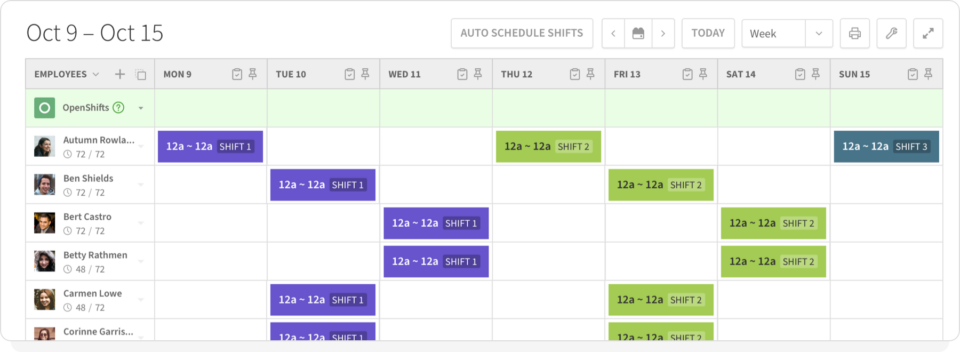
The 24-48 schedule is a simplified shift rotation schedule that gives each team member 24 hours on shift and 48 hours off. This gives you flexibility in the three-day cycle, as well as divides your shifts into three different options, instead of just day and night.
Using scheduling software like When I Work to keep track of your rotating shifts in the 24-48 schedule is essential. Messing up an employee’s days off could lead to them working impaired and increase accidents. Let the software automate the schedule so you can be sure your team gets the rest they need.
Here are the pros and cons of the 24-48 schedule:
Advantages of the 24-48 schedule
The 24-48 schedule is popular in the emergency services field, for good reason. It ensures continuity, so there isn’t a complete shift changeover. There’s always someone still available to provide services or care, even as one shift leaves and another arrives.
- Employees have a good balance between work and rest, as it is nearly equal.
- Allows for a day of rest, and another day to be with family or at home.
- Full-time employees only work a few days a week.
- In some industries, the 24-48 schedule is a popular choice, so employees are accustomed to it.
There are some important points to consider before you commit to the 24-48 schedule.
Disadvantages of the 24-48 schedule
Not everyone functions well staying awake and alert for a full 24 hours, and that leads to some problems.
- Some employees, depending on their place on the schedule, might be stuck working a holiday two years in a row.
- Some employees may not be able to handle a full 24-hour shift.
- If the shift is busy, 24 hours is a long time to be working at full capacity.
- Overtime opportunities are difficult, as rest time is important to recover from a full 24 hours of work.
If you like the continuity of the 24-48 schedule, and the cadence of the Pitman schedule, the 4-3 schedule might be right for you.
4-3 schedule
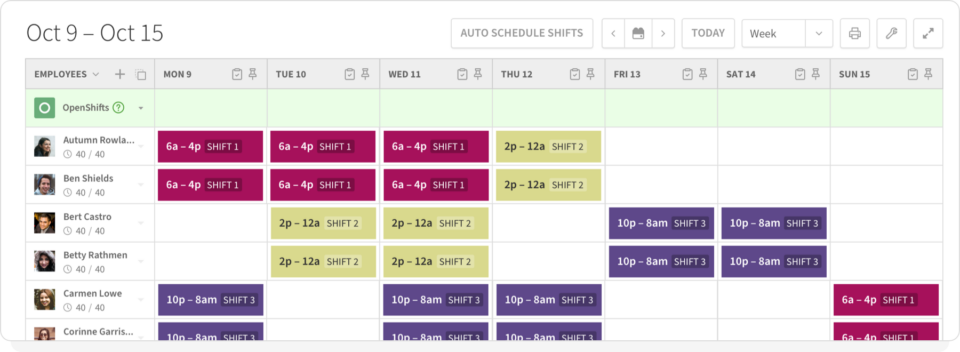
The 4-3 schedule is a great way to ensure coverage continuity while also building a schedule that gives three days off between first, second, and third shift. This offers the best of both worlds, with enough time to rest before you change the timing of shifts and shorter shifts that don’t require 12 or 24 hours.
You can make the scheduling for this option so much easier with When I Work. Between three different shift times, however many teams you have, three days off, and four days on, it’s bound to get a little confusing. Reduce your errors and save yourself time with automated scheduling software.
Here’s what you need to know:
Advantages of the 4-3 schedule
The 4-3 schedule is basically a compressed workweek, which has some real advantages. You get the coverage continuity of three different shifts, but without the huge gaps of time off.
- Every week has a three-day weekend for employees.
- Longer shifts make it possible to focus and complete tasks.
- Employees don’t spend as much time or money on commuting to work because they only work four days a week.
Some things to consider:
Disadvantages of the 4-3 schedule
A compressed workweek like the 4-3 can lead to challenges for employees. The timing can be confusing, because it feels like you’re packing five days of work into four.
- Employees must work longer days, which can lead to burnout.
- Staffing coverage can be tricky for the off days; longer shifts make it less appealing for employees to grab at overtime opportunities.
- For 24/7 businesses, this schedule might cause gaps in coverage depending on the structure of your teams.
- The three days off rotate, making it difficult to plan personal life.
Rotating shift schedule comparison table
Here’s a quick, at-a-glance look at all four rotating shift schedules and how they stack up against each other, so you can choose the one that’s right for your business.
| DuPont | Pitman | 24-48 | 4-3 | |
| Shift length | 12 hours | 12 hours | 24 hours | 10 hours |
| Cycle length | 4 weeks | 2 weeks | 3 days | 1 week |
| Time off | Week 1: 3 days Week 2: 1 day Week 3: 3 days Week 4: 7 days | Week 1: 2 days Week 2: 3 days | 2 days | 3 days |
| Pros | • Employees have time to adjust between day and night shifts • Employees get a week each month to rest and recharge • There are always 2 teams on the clock | • Employees won’t work more than 3 consecutive days • Employees form close connections to their team, which boosts productivity and morale | • There’s a good balance between work and time off • It’s the industry standard for EMS, so most employees are used to it | • Employees get a 3-day weekend every week • Longer shifts make it easier to get tasks done without being exhausting |
| Cons | • No set days off for employees to plan around • 1 week of the month has employees working 6 12-hour shifts, which is exhausting • You have to tightly manage the schedule to make it work | • 12-hour shifts can be exhausting • There’s a really quick adjustment between day and night shifts that can be hard on employees | • 24 hour shifts are very long to be continuously working • Overtime can be difficult to give out because of the shift lengths • Employees may have to work multiple holidays in a row | • Day off coverage can be tricky • There may also be gaps in coverage for businesses that run 24/7 |
Now that you’ve seen the main types of rotating shift schedules, let’s take a look at the reasons you should, or shouldn’t, choose one for your team.
Benefits of the rotating shift schedule
The advantages of rotating shifts are clear for everyone, including your customers, your employees, and your business.
Rotating shifts make it easier for you to ensure your best workers work through all the possible shifts, so all of your customers have a great experience, no matter what time of day or night. Plus, you’ll create more collaboration and cross-training opportunities as your other workers interact with your high-performing talent and learn by being around them. And of course, being able to cover all of the possible shifts lets your business be open for more hours, with happier employees.
Strengthening team dynamics with rotating shifts
While there are no “good” or “bad” shifts, there are definitely shifts that your employees prefer for one reason or another. Some shifts make employees happier than other shifts.
Rotating shift schedules help strengthen your team because employees get to work with others as they rotate across shifts.
They expand their own personal network with other people, discovering different ways of working. Until you’ve worked all of the shifts, you’ll lack the experience and a chance to understand a complete picture of how everything functions. This is particularly important if you allow shift swaps; sooner or later, they’ll probably pick up a different shift. It’s better if everyone has experience working with all of them.
Financial considerations of rotating shifts
For some industries, like restaurants, rotating shifts give every worker a chance at making better tips during high-volume shifts.
If you’re stuck on a low-volume shift, you’ll never get the great tips. Giving every employee an equal opportunity when it comes to different shifts helps improve engagement and morale. It also prevents monotony.
Training and flexibility—advantages for employers
Employers benefit too, of course.
For one thing, the mixing of employees helps in training new employees, exposing them to others who can show them the ropes and the tricks of the trade. Plus, they get a more flexible workforce who are able to pick up shifts when someone is absent, and employees whose talents are spread out across all the shifts.
And with rotating shifts, you avoid some of the frustrations that employees have over their schedule, such as favoritism.
Additionally, using a rotating shift schedule can boost your business outcomes by improving efficiency. Here are a few more benefits of rotating shift schedules:
- Better customer experience—your high performers are working all hours of the day, not just on one particular shift.
- Better employee morale—your workers know they won’t be stuck on the least-enjoyed shifts forever.
- Better operational efficiency—keep your doors open longer, with minimal disruptions, and increase your bottom line.
Related read: 12 Great Employee Retention Strategies
Challenges of the rotating shift schedule
Rotating shift schedules can take a toll on your employees. The inconsistencies of switching back and forth every few weeks make it difficult to plan ahead. And the physical changes from changing up your sleep schedule can have a distinct effect on your employees’ lives. Make sure to do your research on rotating shifts and how to gently ease your employees in and out of changes for their mental and physical health.
- Inconsistent scheduling is disruptive to your employee’s personal life.
- The physical impact of switching from days to nights shouldn’t be overlooked—employee health can decline after just 10 days of rapid schedule change.
- Choose the rotating shift schedule that’s easiest for your employees to reduce turnover.
How to create a rotating work schedule for your business
Planning your shifts is important for everything from labor costs to customer satisfaction. But when it comes to setting up a rotating schedule, it doesn’t hurt to think of your employees first.
With night shift work, especially, avoid making the same employees work them. While some may prefer or even request it, it’s best to not deprive the same people of sleep or the ability to have personal time in the evenings.
With that in mind, the process is simple.
- Break up your day into shifts. How you break up the hours into shifts depends on your business. If you’re open 16 hours a day, you could break it up into two eight-hour shifts. If you’re open 24 hours a day, then you’d be looking at three eight-hour shifts.
- Determine coverage. Again, depending on your business, you may not have the same amount of employee coverage for each shift. Determine how many employees, and any special skills, that must be present for each shift. Some shifts may be busier than others, and require more employees.
- Create teams. How you create teams to cover the shifts depends on whether you have the same number of people on every shift, whether some shifts have more, and if you’ll be mixing the employees or having the same team work together.
- Determine the rotation. Will you use the frequent, slow, weekend, or partial approach? Will it be a mix? Again, keep in mind what’s best for your employees and your company culture, as well as the industry you’re in. What works for a hospital isn’t necessary for a restaurant.
- Automate the process. Build schedule templates that you can copy and paste to avoid human error. This ensures that employees always get enough time off between rotations. Use a free 14-day trial of When I Work to test out templates and scheduling and see how it can help your team.
An example of this might be creating two teams for two eight-hour shifts.
Team one might work the first shift for a week, while team two works the second. The following week, the teams will switch shifts.
There are always going to be complications. You’ll have to manage time-off requests, which will lead to shift swapping among employees. Keep an eye out to make sure one employee isn’t getting stuck with the same shifts due to that swapping. It’s easy to miss if you’re only keeping a bird’s-eye view of the teams instead of the individual.
Get expert tips, best practices, and innovative employee scheduling solutions from the When I Work Blog.

How When I Work helps businesses manage rotating shift schedules
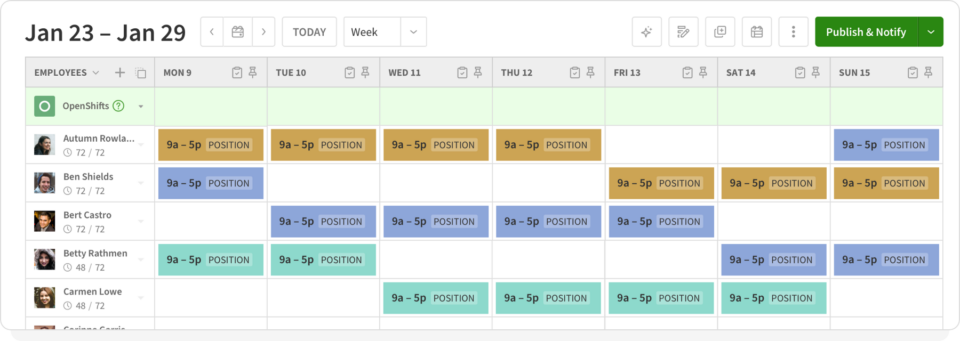
If you’re worried about spending too much time managing rotating shifts, When I Work has you covered. You can use shift templates to easily set up your rotating shift schedule once and then use it over and over again. Managers report that they’re able to build the schedule eight times faster than before.
Plus, if an employee needs to miss a shift, it can cause a lot of rework for you. But when you use When I Work, they can swap that shift with another employee to take the task off of your plate. You can even choose whether you want to approve shift swaps or just let your team manage them on their own.
Sign up now to try free employee scheduling software from When I Work and see how much time you can save with rotating schedules.
Plan your rotating shift schedules with When I Work
Rotating shift schedules give everyone an equal chance to work on preferred or less-preferred days and shifts. They provide you with better coverage while giving employees a chance to better balance work hours with personal life. Get started with scheduling software that can make your rotating shift schedule a reality sooner rather than later. Sign up for your 14-day FREE trial to start building a better work schedule right now with When I Work.
Start your free 14-day trial of When I Work! Click here to start scheduling your employees today.

FAQs: Rotating schedules
Q: What is a rotating schedule?
A: A rotating schedule is a set of scheduled shifts that change over time, usually in a particular pattern. It allows employees to work through different shifts and ensures fair shift coverage.
Q: What are the advantages of a rotating shift schedule?
A: The advantages of a rotating shift schedule include better customer experience, improved employee morale, and enhanced operational efficiency. It allows high-performing employees to work all shifts, provides collaboration and cross-training opportunities, and enables businesses to be open for more hours.
Q: What are the disadvantages of a rotating shift schedule?
A: Rotating shift schedules can take a toll on employees. The inconsistencies and rapid schedule changes make it difficult to plan ahead and can have a negative impact on employee health. It’s important to consider the physical and mental well-being of employees when implementing rotating shifts.
Q: What are the different types of rotating shifts?
A: The four main types of rotating shifts are frequent rotating shift schedules, slow rotating shift schedules, rotating weekend schedules, and partial rotating shift schedules. Each type has its own benefits and considerations.
Q: How can I create a rotating shift schedule for my business?
A: To create a rotating shift schedule, you need to break up your day into shifts, determine coverage requirements for each shift, create teams to cover the shifts, and decide on the rotation approach that works best for your employees and company culture. Consider using scheduling software to make the process easier.
Q: What are some examples of rotating shift schedules?
A: Examples of rotating shift schedules include the DuPont schedule, Pitman schedule, 24-48 schedule, and 4-3 schedule. These schedules vary in terms of shift duration, cycle length, and time off between shifts.
Q: How can When I Work help with planning rotating shift schedules?
A: When I Work is a scheduling software that can simplify the process of creating and managing rotating shift schedules. It allows you to set up shift rotations, assign teams, and customize the schedule according to your needs.






